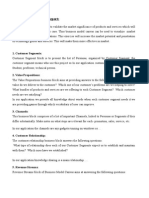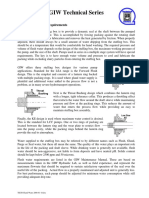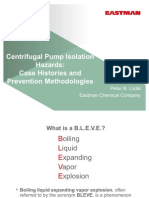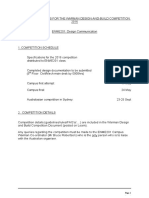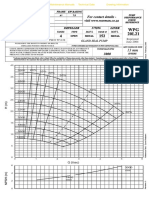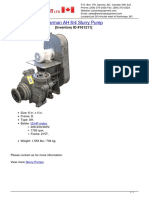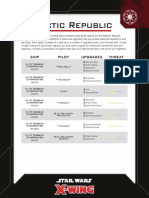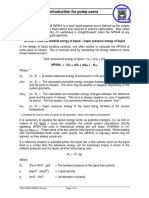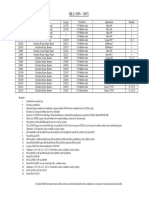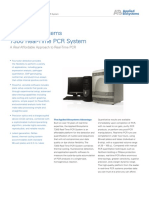GIW Technical Series: Pumping Through An Idle Pump
GIW Technical Series: Pumping Through An Idle Pump
Uploaded by
Travis SkinnerCopyright:
Available Formats
GIW Technical Series: Pumping Through An Idle Pump
GIW Technical Series: Pumping Through An Idle Pump
Uploaded by
Travis SkinnerOriginal Title
Copyright
Available Formats
Share this document
Did you find this document useful?
Is this content inappropriate?
Copyright:
Available Formats
GIW Technical Series: Pumping Through An Idle Pump
GIW Technical Series: Pumping Through An Idle Pump
Uploaded by
Travis SkinnerCopyright:
Available Formats
GIW Technical Series
Pumping through an Idle Pump
In general, the practice of “pumping through” an idle pump should be avoided. Energy is wasted
and the wetted parts of the pump will still wear out, in some cases faster than a normally operating
pump, due to the undesirable flow patterns caused by pumping through.
In cases where this practice cannot be avoided, the following points should be remembered:
1. The flow through a pump that is being “pumped through” will cause it to rotate slowly in the
forward direction.
2. The speed of rotation will depend on the amount of friction in the drive train. Assuming that
this amounts to less than 10% of normal running torque, the pump will turn at 25% to 30% of
normal running speed.
3. The pressure drop across the pump under this freewheeling condition will be approximately
30% of the head under normal operation at the same flow.
4. If the rotor is locked, the pressure drop will increase to approximately 60% of normal running
head and the shaft torque will increase to approximately 45% of normal running torque.
5. Locking the rotor is NOT recommended, partly due to safety concerns on restart and partly due
to danger of unscrewing the impeller (see next item).
6. While being pumped through, the torque on the impeller will always be negative, meaning that
the impeller could be unscrewed if it is not properly tightened. The danger of this can be greatly
reduced by:
a. Allowing the pump to freewheel (no locked rotor).
b. Insuring that the pump is run at normal speed and power before it is allowed to be “pumped
through” any time the impeller is removed and replaced (or in the case of a new pump that
has never run). This will insure that the impeller is tightened as much as possible and
virtually eliminates the possibility of unscrewing due to being pumped through.
In some rare applications, this pre-tightening is not possible. In these cases, a locking nut
can be designed to hold the impeller to the shaft. However, this is a non-standard part that
would generally have to be custom designed and which significantly increases the cost of
the shaft and impeller.
Note that the unscrewing of impellers can also occur under certain conditions of back flow and
reverse rotation. This subject is covered in another GIW Tech Article titled: “Reverse Rotation
and Flow”. Contact your GIW representative for a copy, or request one via our website:
“giwindustries.com”.
TECH Pumping through an Idle Pump 2009-04-02.doc
You might also like
- Thought Works Case StudyDocument3 pagesThought Works Case Studyhye_rituNo ratings yet
- BMC ReportDocument2 pagesBMC Reportwajidgujarati80% (5)
- TECH - Reverse - Rotation - FlowDocument1 pageTECH - Reverse - Rotation - FlowTravis SkinnerNo ratings yet
- GIW Technical Series: Stuffing Box Water RequirementsDocument3 pagesGIW Technical Series: Stuffing Box Water RequirementsTravis SkinnerNo ratings yet
- RYC Shouldered Couplings - Final 3Document3 pagesRYC Shouldered Couplings - Final 3Justin CorbettNo ratings yet
- Lodal Pump BLEVE Mar2011Document47 pagesLodal Pump BLEVE Mar2011khaiseah9225No ratings yet
- Krebs Mill Max Centrifugal Slurry Pump We BXDocument8 pagesKrebs Mill Max Centrifugal Slurry Pump We BXPhani100% (1)
- GIW Technical Series: Stuffing Box Water RequirementsDocument3 pagesGIW Technical Series: Stuffing Box Water RequirementsTravis SkinnerNo ratings yet
- Ex of Goal ProgrammingDocument13 pagesEx of Goal ProgrammingSubir ChakrabartyNo ratings yet
- CPE 325: Embedded Systems Laboratory Laboratory Assignment #4Document2 pagesCPE 325: Embedded Systems Laboratory Laboratory Assignment #4Sheeraz AliNo ratings yet
- The Book of the Singer Junior - Written by an Owner-Driver for Owners and Prospective Owners of the Car - Including the 1931 SupplementFrom EverandThe Book of the Singer Junior - Written by an Owner-Driver for Owners and Prospective Owners of the Car - Including the 1931 SupplementNo ratings yet
- GIW Technical Series: Moving Mounted Pump and Drive AssembliesDocument1 pageGIW Technical Series: Moving Mounted Pump and Drive AssembliesTravis SkinnerNo ratings yet
- GIW Technical Series: Vents and BreathersDocument1 pageGIW Technical Series: Vents and BreathersTravis SkinnerNo ratings yet
- Mill Circuit - Pump ApplicationDocument38 pagesMill Circuit - Pump ApplicationOzy PratazikiNo ratings yet
- GIW Technical Series: Impeller Removal TechniquesDocument2 pagesGIW Technical Series: Impeller Removal TechniquesTravis SkinnerNo ratings yet
- TECH Bearing Housing Asm Bolt TorquesDocument1 pageTECH Bearing Housing Asm Bolt TorquesTravis SkinnerNo ratings yet
- GIW Technical Series: Pipe Flange BoltsDocument4 pagesGIW Technical Series: Pipe Flange BoltsTravis SkinnerNo ratings yet
- GIW Technical Series: Pump StorageDocument1 pageGIW Technical Series: Pump StorageTravis SkinnerNo ratings yet
- GIW Technical Series: Temperature ExtremesDocument2 pagesGIW Technical Series: Temperature ExtremesTravis SkinnerNo ratings yet
- GIW Technical Series: Sub-Base DesignDocument3 pagesGIW Technical Series: Sub-Base DesignTravis SkinnerNo ratings yet
- G101 Glossary of TermsDocument2 pagesG101 Glossary of TermsVincent IrawanNo ratings yet
- GIW Technical Series: TBC Wet End Assembly InstructionsDocument2 pagesGIW Technical Series: TBC Wet End Assembly InstructionsTravis SkinnerNo ratings yet
- GIW Technical Series: Shaft Sleeve RemovalDocument1 pageGIW Technical Series: Shaft Sleeve RemovalTravis SkinnerNo ratings yet
- GIW Technical Series: Pump Bearing TemperatureDocument1 pageGIW Technical Series: Pump Bearing TemperatureTravis SkinnerNo ratings yet
- GIW Technical Series: Sound AdviceDocument1 pageGIW Technical Series: Sound AdviceTravis SkinnerNo ratings yet
- A112 Comparison of Screen SizeDocument1 pageA112 Comparison of Screen SizeVincent IrawanNo ratings yet
- GIW Technical Series: Cold Weather Operation and StorageDocument2 pagesGIW Technical Series: Cold Weather Operation and StorageTravis SkinnerNo ratings yet
- Case Histories of Pump Explosions While Running Isolated (Giles Lodal 2001)Document5 pagesCase Histories of Pump Explosions While Running Isolated (Giles Lodal 2001)rachitNo ratings yet
- GIW Technical Series: GroutingDocument1 pageGIW Technical Series: GroutingTravis SkinnerNo ratings yet
- Weir SPEC-PT-01 Complete Paint Specification DocumentDocument8 pagesWeir SPEC-PT-01 Complete Paint Specification DocumentJessicaNo ratings yet
- Determining Why Objects Are RequiredDocument24 pagesDetermining Why Objects Are Requiredmaga2000No ratings yet
- KREBS-25 Natural RubberDocument1 pageKREBS-25 Natural Rubbermipo.scl.clNo ratings yet
- Troubleshooting Mechanical Seals at The Pump SiteDocument10 pagesTroubleshooting Mechanical Seals at The Pump Siteابو المعالي الهمامNo ratings yet
- CertifiedDocument1 pageCertifiedIta BarreraNo ratings yet
- KSB LCC MDocument126 pagesKSB LCC MAlexander Alonso FernándezNo ratings yet
- Only Schurco "Standard" Parts Are Shown. Alternate Materials, Bearing Seals, Gland Sealing, and Impellers Are AvailableDocument3 pagesOnly Schurco "Standard" Parts Are Shown. Alternate Materials, Bearing Seals, Gland Sealing, and Impellers Are AvailableEduardo MolanoNo ratings yet
- KETO Pumps K-HS Product Brochure - A4 - 0Document7 pagesKETO Pumps K-HS Product Brochure - A4 - 0euan crozier100% (1)
- Linatex HoseDocument7 pagesLinatex HoseIgnacio Moratinos Castañeda100% (1)
- 1345 John CraneDocument2 pages1345 John CraneseptixNo ratings yet
- Mill MAX8 PG EmailversionDocument5 pagesMill MAX8 PG EmailversionPrimitivo GonzálezNo ratings yet
- PABT Battlemax QR Range BrochureDocument2 pagesPABT Battlemax QR Range Brochuresf wNo ratings yet
- 8 - 6F Ah-5vcmDocument1 page8 - 6F Ah-5vcmMamiherintsoa Issaia RanaivoarimananaNo ratings yet
- R05323 P 001a X009 0042 PDFDocument464 pagesR05323 P 001a X009 0042 PDFcquibajoNo ratings yet
- 3196 I FRAME BulletinDocument24 pages3196 I FRAME BulletinGILBERTO YOSHIDANo ratings yet
- WMA06 Section 3.0 Presentation Rev1aDocument112 pagesWMA06 Section 3.0 Presentation Rev1aLeo PalNo ratings yet
- Analisis de La Performance de Una Bomba WarmanDocument82 pagesAnalisis de La Performance de Una Bomba WarmanemersonNo ratings yet
- Brochure BBMRP 4879 05 23 en MNGDocument8 pagesBrochure BBMRP 4879 05 23 en MNGRonak Bhandari100% (1)
- WMA06 Section 6.0 Presentation Rev1aDocument47 pagesWMA06 Section 6.0 Presentation Rev1aLeo PalNo ratings yet
- Coldroom Shelf AaDocument7 pagesColdroom Shelf Aaanon_622910368No ratings yet
- 0-WD745-EJ610-00001 - Rev.1 - Operation and Maintenance Manuals For Control ValveDocument100 pages0-WD745-EJ610-00001 - Rev.1 - Operation and Maintenance Manuals For Control Valveraul gonzalezNo ratings yet
- Product Bulletin 19Document2 pagesProduct Bulletin 19RANAIVOARIMANANANo ratings yet
- Weir Projects QCPDocument1 pageWeir Projects QCPJessicaNo ratings yet
- 2 - 2 TCDocument1 page2 - 2 TCMamiherintsoa Issaia RanaivoarimananaNo ratings yet
- Product Bulletin 15Document2 pagesProduct Bulletin 15RANAIVOARIMANANANo ratings yet
- WARMAN Guidelines 2016Document7 pagesWARMAN Guidelines 2016Glass-Half-EmptyNo ratings yet
- WEIR - Technical Bulletin - Hazards of Blocked PipesDocument6 pagesWEIR - Technical Bulletin - Hazards of Blocked PipesWesley MendesNo ratings yet
- 4 - 3D Ah-5vcmDocument1 page4 - 3D Ah-5vcmMamiherintsoa Issaia RanaivoarimananaNo ratings yet
- EMW Tech Book 1.2Document15 pagesEMW Tech Book 1.2samuel humphreys100% (1)
- WPG 151AH31: 14 MM 14 MMDocument24 pagesWPG 151AH31: 14 MM 14 MMMamiherintsoa Issaia RanaivoarimananaNo ratings yet
- Wpa1210a20 1Document1 pageWpa1210a20 1carlos.delatorreNo ratings yet
- WPG 20L21: 13 MM 13 MMDocument1 pageWPG 20L21: 13 MM 13 MMMamiherintsoa Issaia RanaivoarimananaNo ratings yet
- Giw Conversion Slurry PumpsDocument2 pagesGiw Conversion Slurry Pumpsmarcosandia1974No ratings yet
- Warman Ah 6 4 Slurry PumpDocument1 pageWarman Ah 6 4 Slurry PumpOscar Guerra100% (1)
- IBC Precision LocknutsDocument12 pagesIBC Precision LocknutsTUĞÇE ÖZGEN GENÇNo ratings yet
- Pump FAQ's by Hydraulic Institute (UK)Document61 pagesPump FAQ's by Hydraulic Institute (UK)Sajjad Ahmed100% (3)
- Update Your Bearing Protector Knowledge: What IsDocument7 pagesUpdate Your Bearing Protector Knowledge: What IsTravis SkinnerNo ratings yet
- Galactic Empire: Quick Build ReferenceDocument7 pagesGalactic Empire: Quick Build ReferenceTravis SkinnerNo ratings yet
- First Order: Quick Build ReferenceDocument3 pagesFirst Order: Quick Build ReferenceTravis SkinnerNo ratings yet
- Galactic Republic: Quick Build ReferenceDocument3 pagesGalactic Republic: Quick Build ReferenceTravis SkinnerNo ratings yet
- VbxxdtechsheetDocument1 pageVbxxdtechsheetTravis SkinnerNo ratings yet
- Resistance: Quick Build ReferenceDocument3 pagesResistance: Quick Build ReferenceTravis SkinnerNo ratings yet
- Rebel Alliance: Quick Build ReferenceDocument8 pagesRebel Alliance: Quick Build ReferenceTravis SkinnerNo ratings yet
- GIW Technical Series: TBC Wet End Assembly InstructionsDocument2 pagesGIW Technical Series: TBC Wet End Assembly InstructionsTravis SkinnerNo ratings yet
- GIW Technical Series: Impeller Removal TechniquesDocument2 pagesGIW Technical Series: Impeller Removal TechniquesTravis SkinnerNo ratings yet
- GIW Technical Series: Sound AdviceDocument1 pageGIW Technical Series: Sound AdviceTravis SkinnerNo ratings yet
- GIW Technical Series: V-Belt vs. Cog Belt DrivesDocument1 pageGIW Technical Series: V-Belt vs. Cog Belt DrivesTravis SkinnerNo ratings yet
- NPSH - An Introduction For Pump Users: 1. General FormulationDocument4 pagesNPSH - An Introduction For Pump Users: 1. General FormulationTravis SkinnerNo ratings yet
- GIW Technical Series: Sub-Base DesignDocument3 pagesGIW Technical Series: Sub-Base DesignTravis SkinnerNo ratings yet
- GIW Technical Series: GroutingDocument1 pageGIW Technical Series: GroutingTravis SkinnerNo ratings yet
- GIW Technical Series: Impeller Lifting JigsDocument1 pageGIW Technical Series: Impeller Lifting JigsTravis SkinnerNo ratings yet
- GIW Technical Series: Temperature ExtremesDocument2 pagesGIW Technical Series: Temperature ExtremesTravis SkinnerNo ratings yet
- GIW Technical Series: Pump StorageDocument1 pageGIW Technical Series: Pump StorageTravis SkinnerNo ratings yet
- GIW Technical Series: Shaft Sleeve RemovalDocument1 pageGIW Technical Series: Shaft Sleeve RemovalTravis SkinnerNo ratings yet
- TECH Bearing Housing Asm Bolt TorquesDocument1 pageTECH Bearing Housing Asm Bolt TorquesTravis SkinnerNo ratings yet
- TECH Pump Vibration Levels PDFDocument1 pageTECH Pump Vibration Levels PDFTravis SkinnerNo ratings yet
- TECH GIW Blue 150 Viscosity CurveDocument1 pageTECH GIW Blue 150 Viscosity CurveTravis SkinnerNo ratings yet
- GIW Technical Series: Pipe Flange BoltsDocument4 pagesGIW Technical Series: Pipe Flange BoltsTravis SkinnerNo ratings yet
- GIW Technical Series: Cold Weather Operation and StorageDocument2 pagesGIW Technical Series: Cold Weather Operation and StorageTravis SkinnerNo ratings yet
- GIW Technical Series: Pump Bearing TemperatureDocument1 pageGIW Technical Series: Pump Bearing TemperatureTravis SkinnerNo ratings yet
- Vibromet : 500V: Single Point Laser Doppler VibrometerDocument11 pagesVibromet : 500V: Single Point Laser Doppler VibrometerTravis SkinnerNo ratings yet
- Rotordynamic Analysis Using XlrotorDocument16 pagesRotordynamic Analysis Using XlrotorTravis Skinner100% (1)
- Air Release Valve: Jeevan Bhar Ka Saath..Document2 pagesAir Release Valve: Jeevan Bhar Ka Saath..arjun 11No ratings yet
- Hog86 2048ppr Incremental EncoderDocument6 pagesHog86 2048ppr Incremental Encodersanjay1508No ratings yet
- EBS-I10 DatasheetDocument3 pagesEBS-I10 Datasheettungnguyenquang1306No ratings yet
- Eurocopter Maintenance Manual B0: TitleDocument53 pagesEurocopter Maintenance Manual B0: TitleCleber SouzaNo ratings yet
- Core-Communicative Skills 2Document175 pagesCore-Communicative Skills 2Prosper Boateng-HodoNo ratings yet
- Staubli Connectors CatalougeDocument28 pagesStaubli Connectors CatalougeSpark MeditechNo ratings yet
- Landing Gear Design-1Document92 pagesLanding Gear Design-1Ab Rahman Adib67% (3)
- Wizarpos Q2Document1 pageWizarpos Q2Surya Paryanta PattraNo ratings yet
- Department of EducationDocument25 pagesDepartment of EducationjajalarawanNo ratings yet
- Referencias Tecnicas Cajas Mini CompDocument6 pagesReferencias Tecnicas Cajas Mini CompRenato GarridoNo ratings yet
- Kaithi Doc NewDocument8 pagesKaithi Doc Newkarthik reddyNo ratings yet
- About UsDocument16 pagesAbout UsManam BerampuramNo ratings yet
- LS 500h Brochure 2023Document30 pagesLS 500h Brochure 2023Shubhanga AithalNo ratings yet
- Structural Steel Connections Made Easy: S A F EDocument8 pagesStructural Steel Connections Made Easy: S A F EMrvn Domingo MalicdemNo ratings yet
- Sega Service Manual - Genesis, Mega Drive PAL, Mega CD - Sega CD, No 010, April, 1994Document32 pagesSega Service Manual - Genesis, Mega Drive PAL, Mega CD - Sega CD, No 010, April, 1994Ed IrvinNo ratings yet
- Social Media Marketing in Luxury Brands: A Systematic Literature Review and Implications For Management ResearchDocument23 pagesSocial Media Marketing in Luxury Brands: A Systematic Literature Review and Implications For Management ResearchAkademis ArkaswaraNo ratings yet
- Applied Biosystems 7300 Real-Time PCR SystemDocument4 pagesApplied Biosystems 7300 Real-Time PCR SystemLiviu Athos TamasNo ratings yet
- 2 Piece Flanged Full Port Ball Valves: Flow-Tek Series F15/F30Document20 pages2 Piece Flanged Full Port Ball Valves: Flow-Tek Series F15/F30Presa de Jales TubincoNo ratings yet
- Blasting List As On 20.02.23Document97 pagesBlasting List As On 20.02.23ISGECFAB YARD2No ratings yet
- Gcaa Car-Moa - Manufacturing Organisation ApprovalDocument15 pagesGcaa Car-Moa - Manufacturing Organisation ApprovalAJMAL MUHAMED K MNo ratings yet
- Washing Instruction FUEL INJECTORSDocument8 pagesWashing Instruction FUEL INJECTORSdallo64No ratings yet
- TDKL S A0008497518 1Document3 pagesTDKL S A0008497518 1Luis AnzolaNo ratings yet
- General Oda Project Proposal Format Cover PageDocument18 pagesGeneral Oda Project Proposal Format Cover PageBillVeelNo ratings yet
- eBU Assignment Spring 2024 - Winter 2024 (6748)Document5 pageseBU Assignment Spring 2024 - Winter 2024 (6748)Marcel JonathanNo ratings yet
- 5GEB20B4Document1 page5GEB20B4CordovaPJNo ratings yet
- Dell Emc Poweredge R640: Technical GuideDocument45 pagesDell Emc Poweredge R640: Technical GuideBa VuVanNo ratings yet

